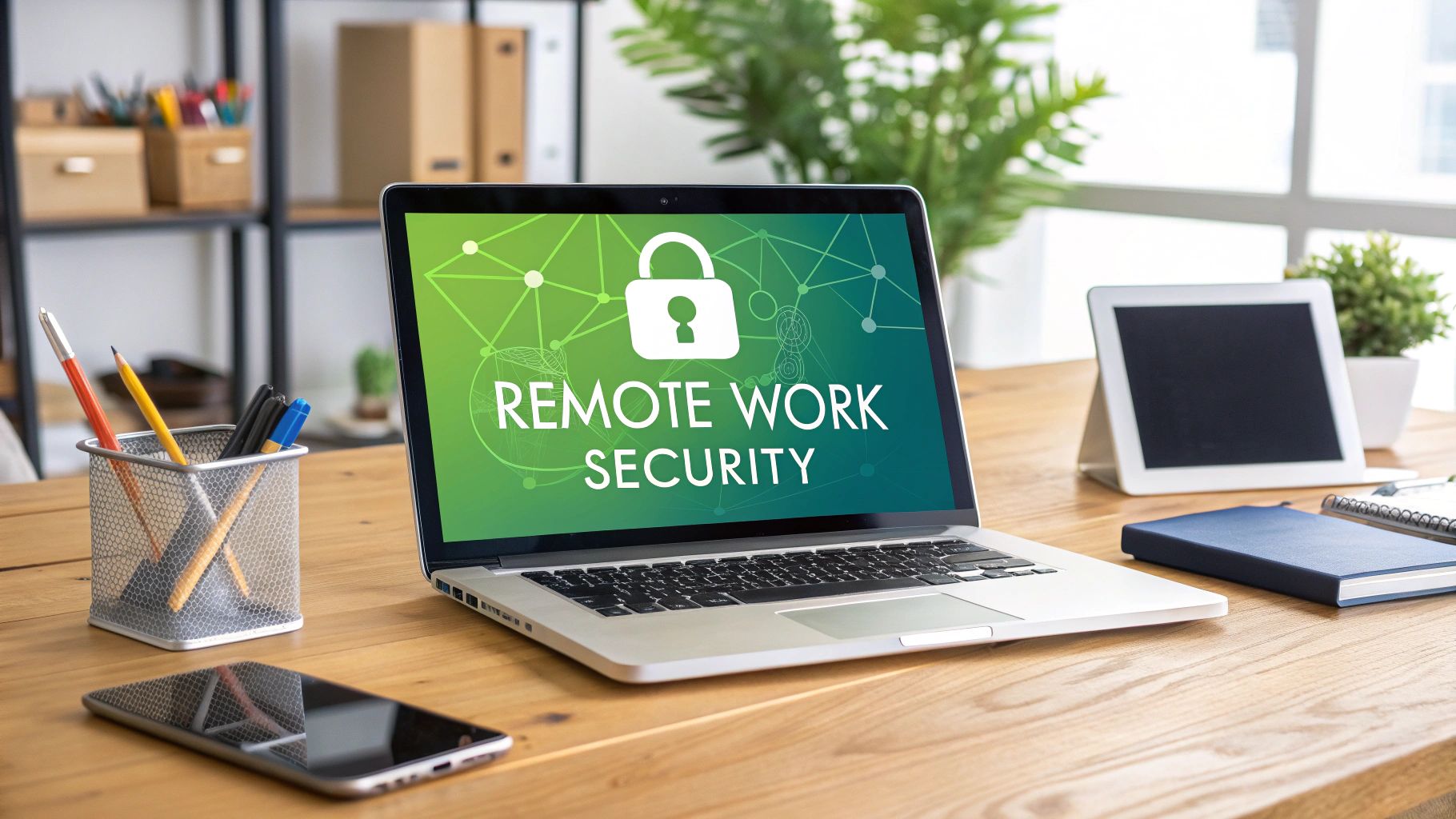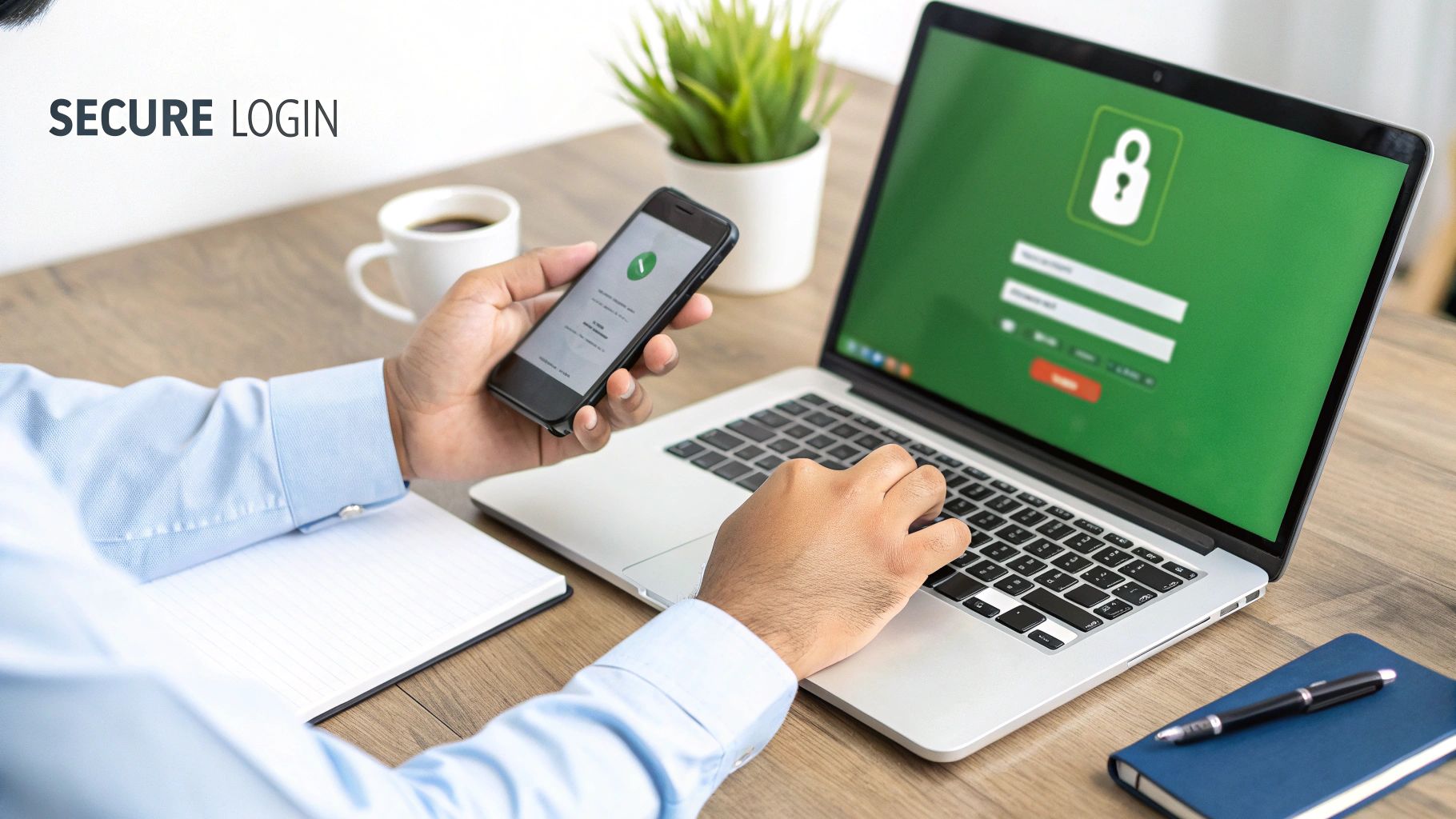To send an encrypted email, you'll need a method that scrambles your message so only the right person can read it. This usually involves tools like PGP, S/MIME, or a dedicated secure email service. Think of it as turning your message from a readable "postcard" into a locked digital safe, keeping it shielded from prying eyes.
Why Encrypting Your Email Is Non-Negotiable
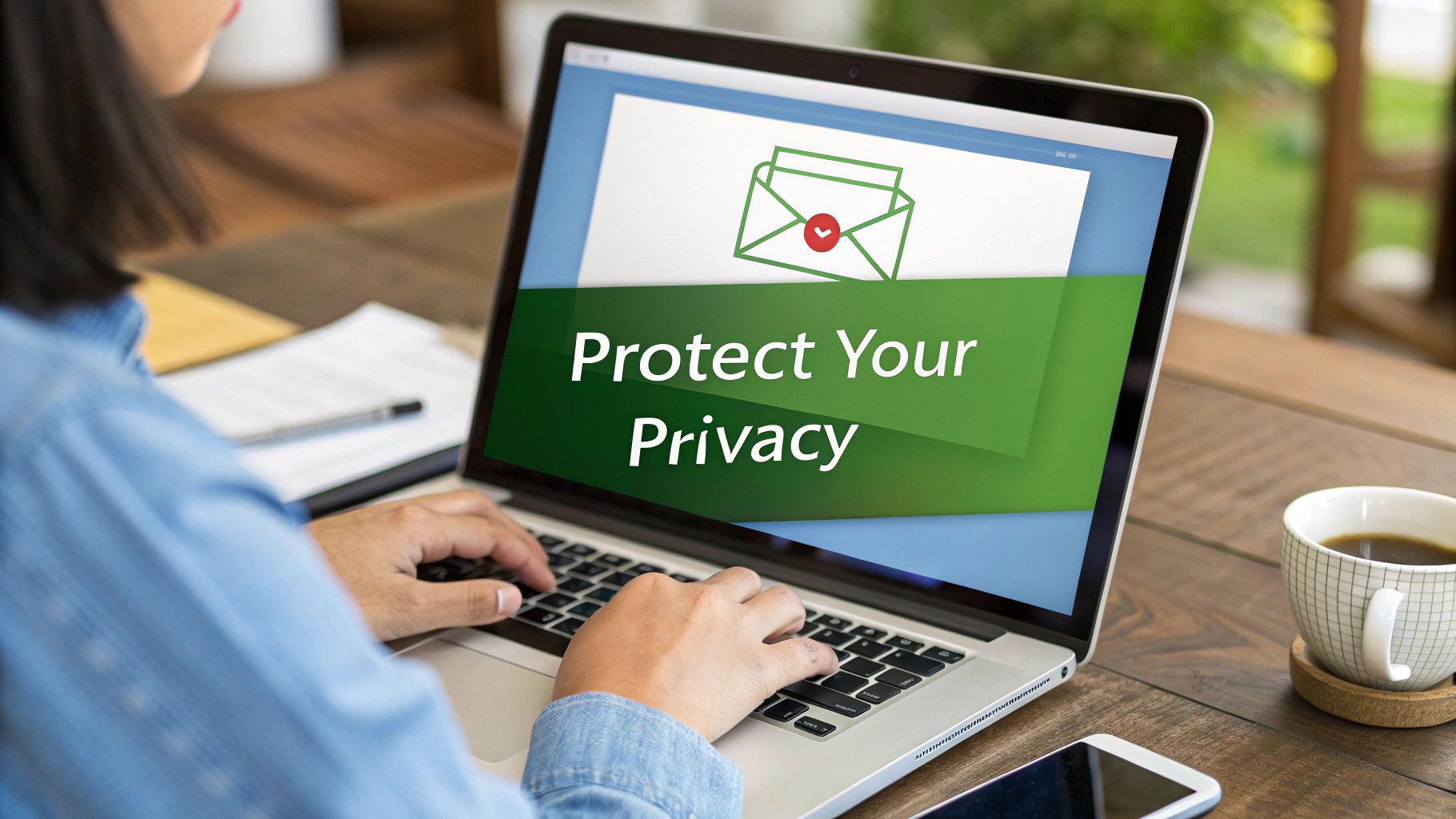
It's easy to assume our emails are private chats, but that couldn't be further from the truth. A standard email travels across the internet completely exposed, almost like a postcard. Anyone from a hacker to an internet service provider could potentially intercept and read every word, creating some serious risks for your personal and professional communications.
Just imagine sending a contract, financial statements, or private health records through an unencrypted channel. You're essentially leaving that sensitive data wide open to theft. A cybercriminal could snatch those details and use them for identity theft, financial fraud, or a devastating business data breach. The fallout is never pretty.
The Real-World Impact of Unsecured Emails
Business Email Compromise (BEC) attacks are a perfect, and frightening, example of why encryption is so critical. In a typical BEC scam, an attacker gets into an email account, impersonates an executive, and tricks an employee into authorizing a fraudulent wire transfer. The financial losses can be massive. An encrypted email workflow throws a major wrench in these kinds of attacks, making them significantly harder to pull off.
Encryption isn't just a technical feature; it's a fundamental practice for digital self-defense. It protects your sensitive conversations from falling into the wrong hands, preserving your privacy and security.
People are waking up to these threats, and it’s fueling a huge shift in how we all handle digital communication. You can see this reflected in the numbers: the global email encryption market was valued at USD 9.30 billion in 2025 and is on track to hit an incredible USD 23.33 billion by 2030.
Keeping your messages private is also essential for building trust, which is the foundation of everything from personal relationships to effective email marketing strategies. Before you dive in, it helps to understand what makes an email truly secure. You can build a solid foundation by checking out our guide: https://typewire.com/blog/read/2025-07-25-define-encrypted-email-a-simple-guide-to-protect-your-data.
Choosing the Right Email Encryption Method
Before you can send an encrypted email, you've got to pick the right tool for the job. This is probably the most critical step, as your choice will dictate everything from the setup process to how easy it is to use day-to-day. It really comes down to how tech-savvy you are, what you need to protect, and who you're communicating with.
For years, the conversation has been dominated by two heavyweights: PGP (Pretty Good Privacy) and S/MIME (Secure/Multipurpose Internet Mail Extensions).
PGP is the classic choice for privacy advocates, journalists, and activists. It’s built on a decentralized model called the "web of trust," where users personally vouch for each other's identities. There’s no big company in the middle.
S/MIME, on the other hand, is the corporate standard. It’s what you’ll find in most government and business settings. It relies on official certificates from a trusted Certificate Authority (CA) to prove you are who you say you are.
Comparing Your Options
Let's be honest: setting up PGP or S/MIME can be a real headache for the average person. This technical barrier is exactly why a new wave of modern encrypted email services, like Typewire, have emerged. They handle all the complex key management stuff for you, offering end-to-end encryption right out of the box.
This visual breaks down the key differences between these approaches, looking at things like encryption strength and how tough they are to set up.
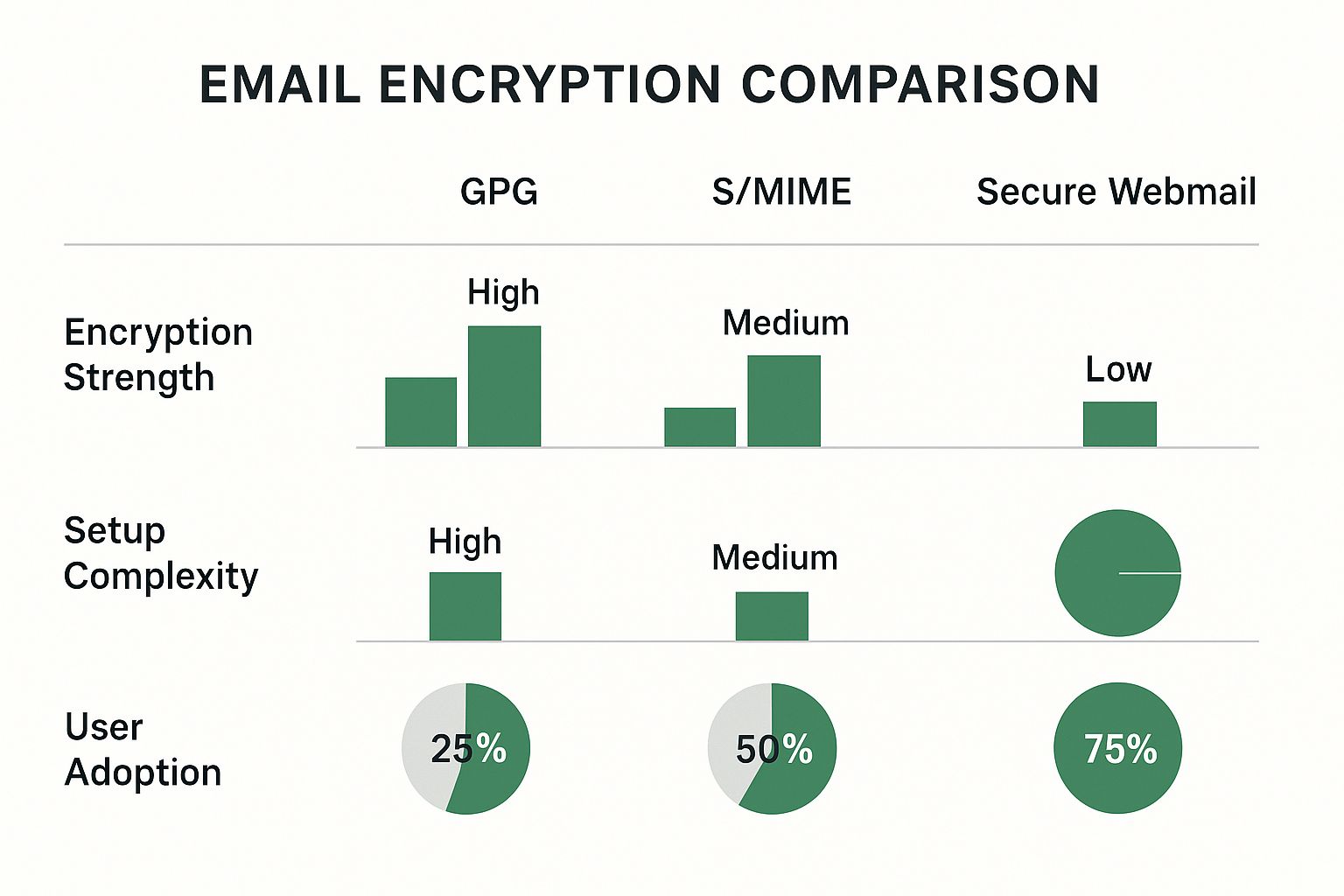
As you can see, while the traditional methods are incredibly powerful, services that simplify the process tend to get used more often simply because they're easier.
To help you decide, let's put these methods side-by-side.
Comparing Email Encryption Methods
This table breaks down the core differences between the main options available today. Think about your own needs as you review it—what's a "must-have" versus a "nice-to-have"?
| Method | Best For | Setup Complexity | Key Management |
|---|---|---|---|
| PGP | Tech-savvy individuals, journalists, activists | High. Requires manual key generation and exchange. | Decentralized. You manage your own keys ("web of trust"). |
| S/MIME | Corporate environments, government agencies, enterprise use | Medium. Requires getting a certificate from a CA. | Centralized. Relies on trusted Certificate Authorities. |
| Modern Encrypted Email Service | Everyday users, small businesses, anyone wanting simple security | Low. Sign up and it works automatically. | Automatic. The service handles all key management. |
Ultimately, PGP and S/MIME offer robust, time-tested security, but they demand technical effort. For most people, a modern service provides more than enough protection without the steep learning curve.
Your choice of encryption method should align directly with your threat model. A journalist protecting a source has different needs than a corporation securing internal financial reports.
Email encryption isn't just a niche tool anymore; it's becoming a fundamental part of digital communication. The numbers back this up: the global email encryption market was valued at USD 7.75 billion and is expected to explode to USD 40.16 billion by 2033. You can dig into the full email encryption market forecast to see just how fast this is growing. By understanding these options, you'll be in a great position to secure your communications.
Sending Encrypted Email with PGP
If you're serious about taking your email security into your own hands, Pretty Good Privacy (PGP) is the way to go. It might sound intimidating, but modern tools have made it much more user-friendly than it used to be. The core idea is simple: PGP gives you a personal, digital lock and key system, so only you and the person you’re writing to can read the message.
Let's walk through the process using Gpg4win, a popular and free encryption suite for Windows. The very first thing you'll need to do is generate your personal key pair.
This isn't as complicated as it sounds. The pair is just two small, mathematically connected files:
- Your Private Key: This one is your secret. Keep it safe and never share it. It’s the only key that can decrypt messages sent specifically to you.
- Your Public Key: This is the key you give out. Think of it like sharing your email address or phone number. People use your public key to lock, or encrypt, a message that only your private key can unlock.
You'll manage these keys using a program called Kleopatra, which comes bundled with Gpg4win.
Exchanging Keys to Communicate Securely
Before you can send a PGP-encrypted email, you need your recipient's public key, and they need yours. This is the handshake that makes the whole system work.
To share your key, you just export it from Kleopatra. It becomes a small file or a block of text you can pop into a regular email and send to your contact. It's not sensitive data, so no need to worry about sending it over an unsecured channel.
When someone sends you their public key, you simply import it into your key manager. This adds them to your list of trusted contacts, letting your email client know you have a way to send them secure messages. Without their public key, you have no way to encrypt an email for them.
The entire system is built on the OpenPGP standard, which has been the gold standard for secure communication for decades.
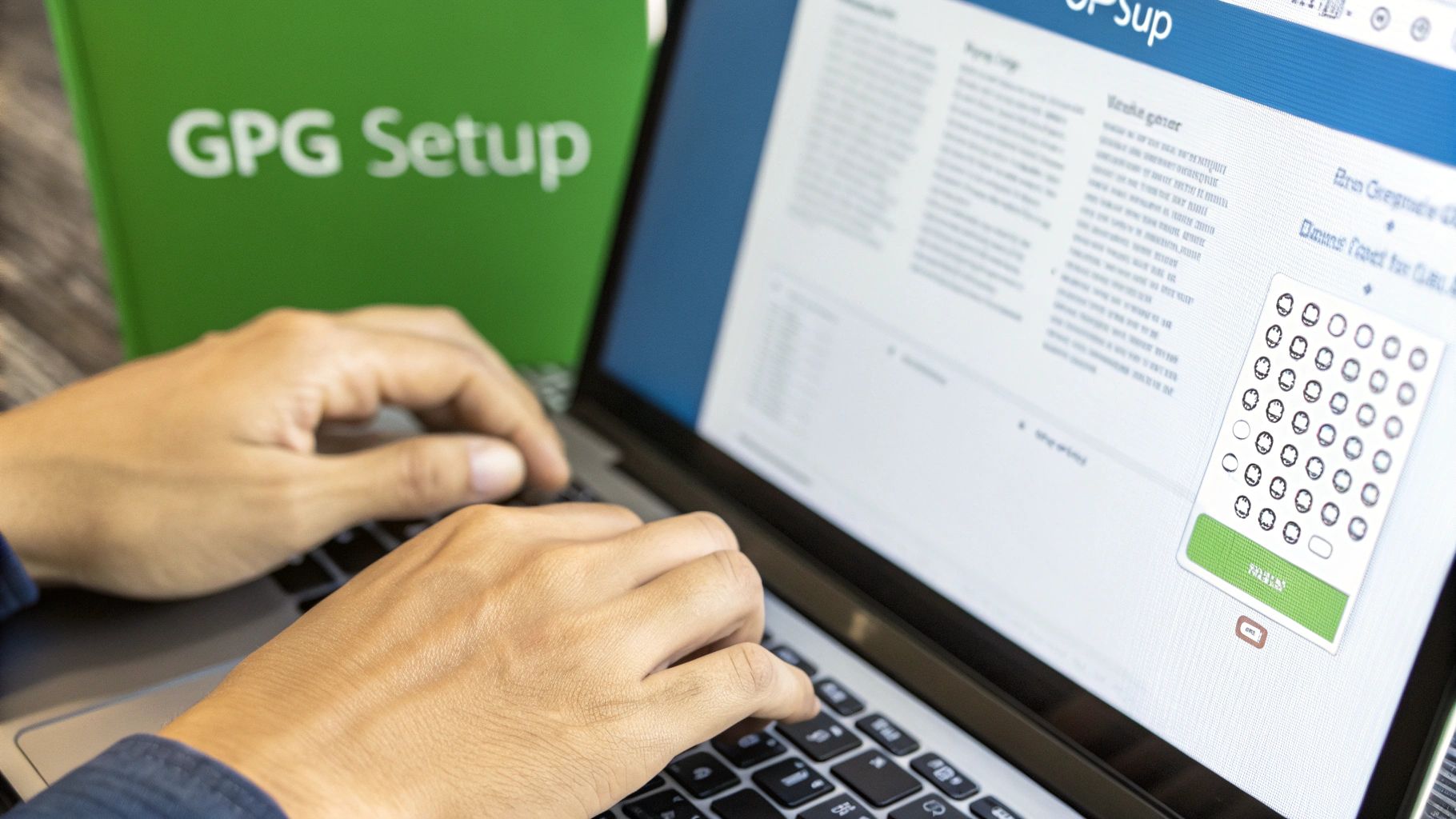
This open-source framework ensures that different PGP applications can all talk to each other, creating a decentralized and incredibly reliable network.
Composing Your First Encrypted Message
Alright, you've swapped keys with a contact. Now you're ready to send a secure message. Most PGP tools plug right into popular email clients like Outlook or Thunderbird.
When you start a new email to someone whose public key you have, you’ll notice new icons or options in the compose window—usually to encrypt and sign. Encrypting locks the message with their public key. Signing uses your private key to leave a digital fingerprint that proves the message is from you.
Pro Tip: I always recommend signing your encrypted messages. It’s a simple click that confirms to the recipient that the email is genuinely from you and wasn’t altered along the way. It’s an essential layer of authentication on top of the privacy.
Imagine you’re a journalist sending sensitive research to an editor. Encrypting the message protects the content from prying eyes. Signing it proves that you are the one who sent it. Your editor uses your public key to verify your signature and their private key to unlock the message. That two-way verification is what has made PGP a trusted tool for critical communications for years.
Getting S/MIME Set Up in Your Email Client
If you're in a corporate or government environment, S/MIME (Secure/Multipurpose Internet Mail Extensions) is likely your go-to for sending encrypted email. It operates differently than PGP. Instead of a web of trust, S/MIME works more like a digital passport system, relying on formal, trusted third parties to verify identities.
It all starts with getting a digital certificate from a Certificate Authority (CA). Think of a CA as a digital notary; they verify your identity and then issue a unique certificate that proves you are who you claim to be. This certificate is the heart of S/MIME, containing your public key and the CA's digital signature of authenticity.
Getting and Installing Your Certificate
Typically, you'll start with a simple online application to get your certificate. You'll provide some identifying details, the CA will run a quick validation check, and once you're approved, they'll send you a certificate file. Look for a file with a .p12 or .pfx extension—this bundle contains both your public and private keys.
With that file saved, it's time to install it in your email client. Thankfully, most major applications make this pretty painless.
- Microsoft Outlook: You'll want to head into the Trust Center settings. There’s usually an option to import the certificate file directly.
- Apple Mail: This is a system-level process. You add the certificate to your Keychain Access, and from there, Mail and other Mac apps can use it.
Once that's done, your certificate is installed and ready to go.
One of the best things about S/MIME is how smoothly it integrates into business email clients. If you're emailing colleagues in the same company, the whole encryption and decryption process often just happens in the background. It's practically invisible.
Telling Your Email Client to Use S/MIME
Installing the certificate is the first half; the second is telling your email program to actually use it. Dive into your email account’s security settings. You'll need to select the certificate you just installed for both digitally signing and encrypting messages. Most clients also give you the option to automatically sign every email you send, which is a good practice.
When you send an encrypted email with S/MIME, your client does two things: it digitally signs the message with your private key and then encrypts it with the recipient's public key. For this to work, the person you're emailing also needs a valid S/MIME certificate.
Managing these digital certificates is the most critical part of an S/MIME setup. For larger teams, handling this manually can be a huge headache. To learn how to streamline this and avoid security gaps, you might want to look into Certificate Automation for Enhancing Digital Security. Automating the deployment and management of certificates across many users makes the whole system much more secure and efficient.
What If You Don’t Want to Deal With All That?
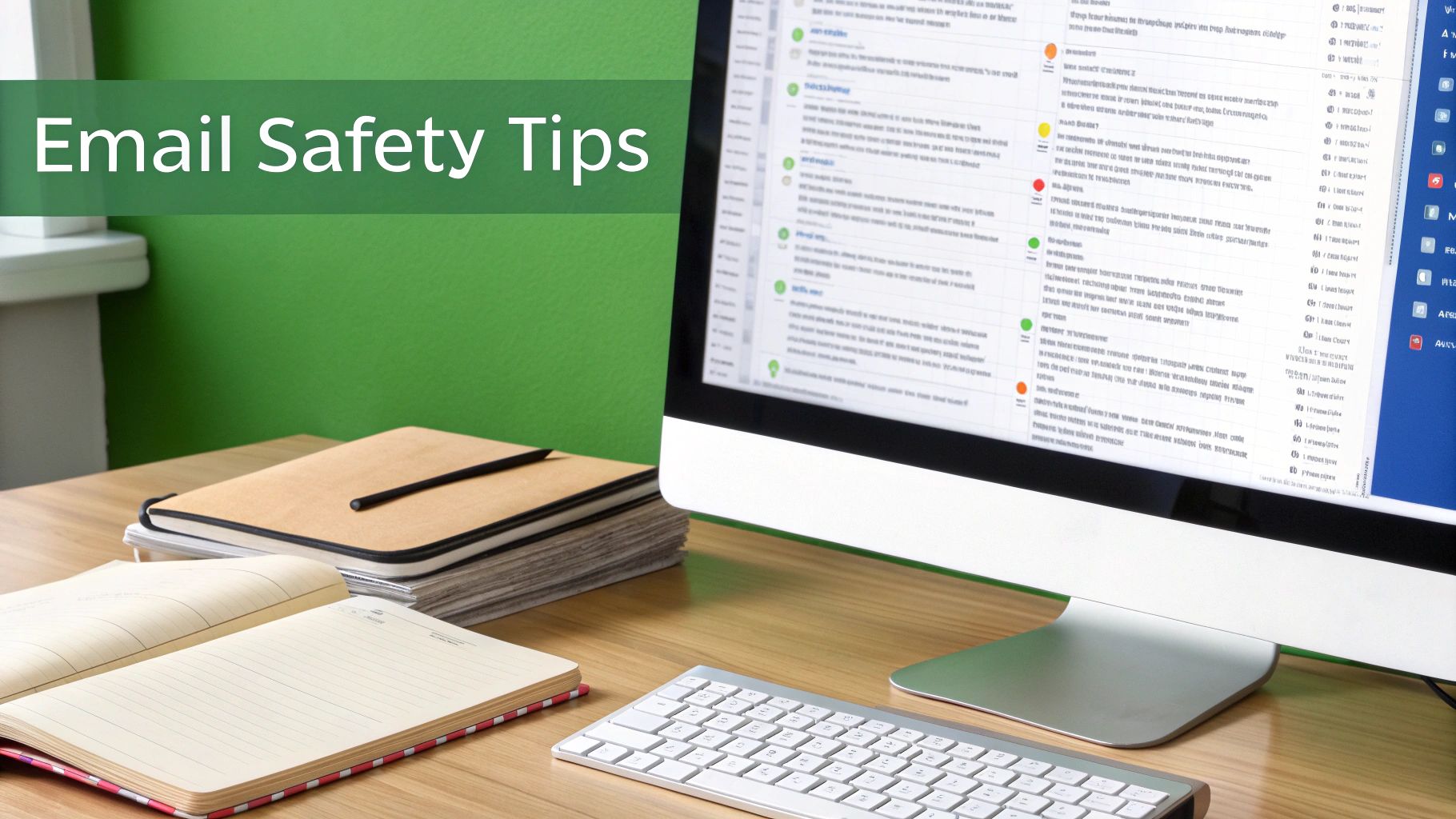
Let's be honest: setting up PGP or S/MIME can feel like a chore. If you're not a tech enthusiast, the manual setup can be a real headache. Thankfully, you're not alone in feeling this way, and there are much simpler options available.
A new wave of email services now offers end-to-end encryption built right in. These platforms are designed for the rest of us, handling all the complicated key management behind the scenes so you can just focus on writing your email.
Security That Just Works
For most people and small businesses, this approach strikes the perfect balance between strong security and day-to-day convenience. Signing up is usually as straightforward as creating any other email account. The moment you start using it, your messages are protected—no plugins or special configurations needed.
The real beauty here is that encryption isn't an afterthought; it's the default. This completely removes the complexity that stops so many people from encrypting their emails. You can send an encrypted email to anyone else on the same service automatically, knowing your conversations are kept private.
The best security tool is the one you actually use. Modern encrypted email providers make robust privacy accessible, proving you don’t need to be a security expert to protect your data.
With daily email traffic projected to hit 392 billion messages in 2025, the need for simple and effective security has never been more obvious. If you're curious about the numbers, a detailed report from cloudhq.net breaks down how these trends are shaping our security needs.
You can also dive deeper into protecting your digital conversations by reading our complete playbook on sending secure emails: https://typewire.com/blog/read/2025-06-18-sending-secure-emails-your-complete-protection-playbook.
Common Questions About Email Encryption
Even with the right tools, it's natural to have a few questions when you're just getting started with encrypted email. Let's walk through some of the most common ones I hear from people, so you can move forward with confidence.
What If I Send an Encrypted Email to Someone Who Can't Open It?
This is probably the number one question. What happens if you go through all the trouble of encrypting a message, only to send it to someone who doesn't have the right setup?
It really depends on the method you're using.
-
With traditional PGP or S/MIME, your email client will likely stop you in your tracks. Since you don't have the recipient's public key to "lock" the message with, you simply won't be able to send it.
-
Many modern secure email services have a clever workaround. They'll send the recipient a normal email with a secure link, inviting them to view the encrypted message on a protected web portal.
TLS vs. End-to-End Encryption: What's the Difference?
You've probably heard of TLS (Transport Layer Security). It's the standard encryption that protects your email in transit—as it travels from your email server to the recipient's. Think of it like an armored truck carrying a letter. The truck is secure, but anyone at the sending or receiving mailroom can still open the letter.
End-to-end (E2E) encryption is different. It encrypts the message itself. From the moment you hit "send" until your intended recipient opens it, the content is completely scrambled. No one in between—not even your email provider—can read what's inside.
Encryption is a powerful defense, but it’s not magic. The entire system's security hinges on keeping your private key completely secret. If that key is ever compromised, so are your encrypted communications.
Is Email Encryption Foolproof?
No security system is 100% unbreakable, but strong E2E encryption makes it incredibly difficult and expensive for anyone to gain unauthorized access.
Ultimately, the weakest link is often human. Your biggest responsibility is protecting your private key. Storing it on a secure device and protecting it with a strong, unique password is just as critical as the encryption algorithm itself.
Of course, even the most secure email won't help if it never arrives. Proper server setup is key, so it's a good idea to improve email deliverability to ensure your messages always land in the right inbox.
Ready to take control of your email privacy without the technical headaches? Typewire offers secure, private email hosting that puts you in charge. Sign up for a free trial today and experience the peace of mind that comes with true data ownership. https://typewire.com


